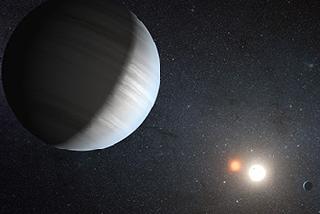
This artist's concept illustrates Kepler-47, the first transiting circumbinary system. A NASA/JPL photo
WASHINGTON (BNS): In a first-ever discovery, NASA's Kepler spacecraft has found a circumbinary planetary system where two planets are orbiting two suns.
The new-found system is located 4,900 light-years from Earth in the constellation Cygnus. It consists of a pair of orbiting stars, called Kepler-47, that eclipse each other every 7.5 days from our vantage point on Earth.
One star is similar to our Sun in size, but only 84 percent as bright. The second star is diminutive, measuring only one-third the size of the Sun and less than 1 percent as bright.
The two planets orbiting the alien solar system are Kepler-47b and Kepler-47c. While the inner planet Kepler-47b orbits the pair of stars in less than 50 days, the outer planet Kepler-47c makes the transit around the host pair in every 303 days.
Kepler-47b, at three times the radius of Earth, is the smallest known transiting circumbinary planet. It is believed to be a sweltering world, where the destruction of methane in its super-heated atmosphere might lead to a thick haze that could blanket the planet.
The outer planet, Kepler-47c, is thought to be a gaseous giant slightly larger than Neptune, where an atmosphere of thick bright water-vapour clouds might exist, according to the researchers. The planet, however, maynot be hospitable for life.
"Unlike our sun, many stars are part of multiple-star systems where two or more stars orbit one another. The question always has been -- do they have planets and planetary systems? This Kepler discovery proves that they do," said William Borucki, Kepler mission principal investigator at NASA's Ames Research Center in Moffett Field, California.
"In our search for habitable planets, we have found more opportunities for life to exist," the researcher added.
The latest discovery comes less than a year after the announcement of the first circumbinary planet, Kepler-16b, and proves that more than one planet can form and persist in the "stressful realm" of a binary star. The discovery demonstrates the diversity of planetary systems in our galaxy, NASA said.
"The presence of a full-fledged circumbinary planetary system orbiting Kepler-47 is an amazing discovery," said Greg Laughlin, professor of Astrophysics and Planetary Science at the University of California in Santa Cruz.
"These planets are very difficult to form using the currently accepted paradigm, and I believe that theorists, myself included, will be going back to the drawing board to try to improve our understanding of how planets are assembled in dusty circumbinary disks," the researcher said.
 Previous Article
Previous Article Next Article
Next Article













The Indian Air Force, in its flight trials evaluation report submitted before the Defence Ministry l..
view articleAn insight into the Medium Multi-Role Combat Aircraft competition...
view articleSky enthusiasts can now spot the International Space Station (ISS) commanded by Indian-American astr..
view article